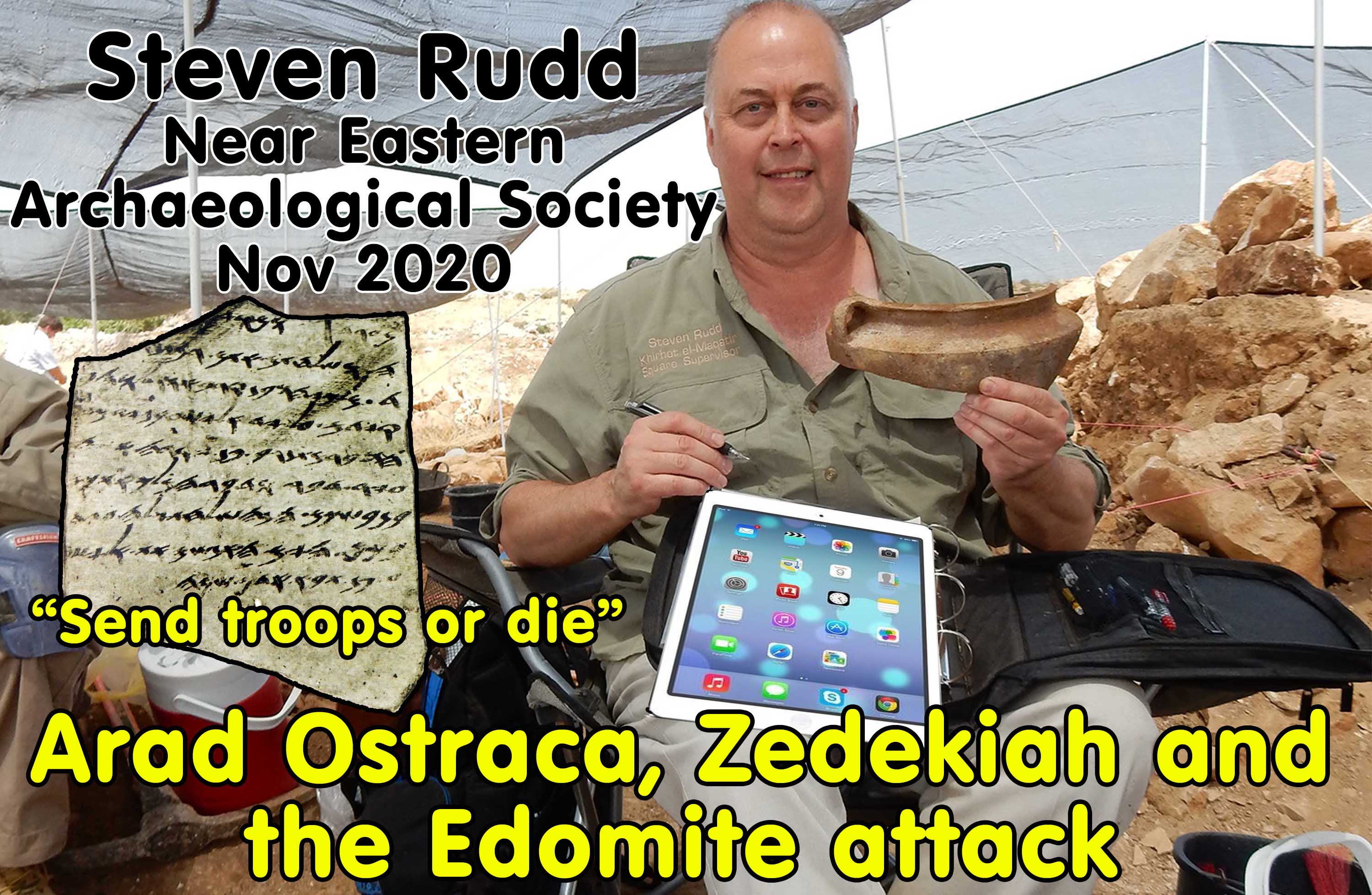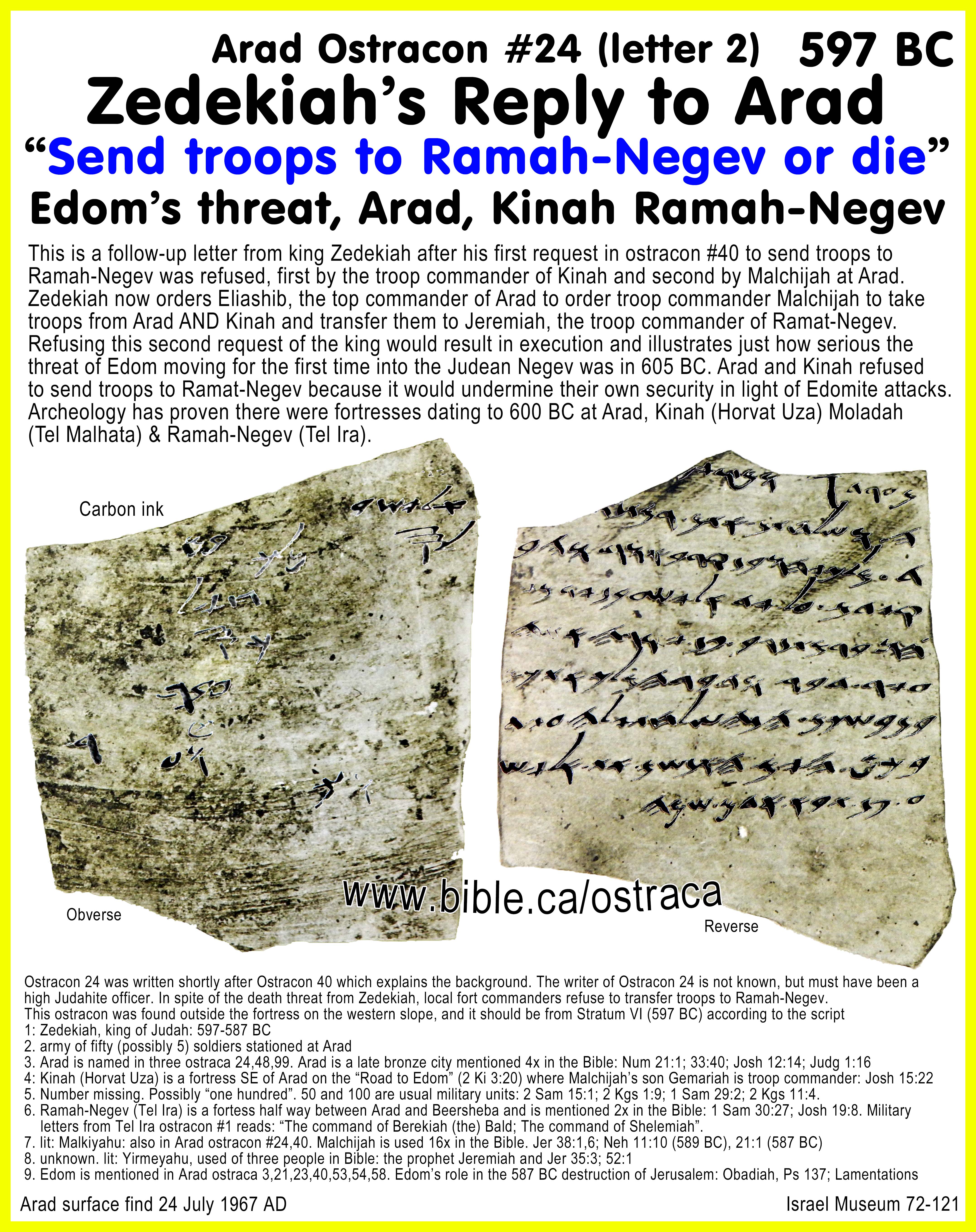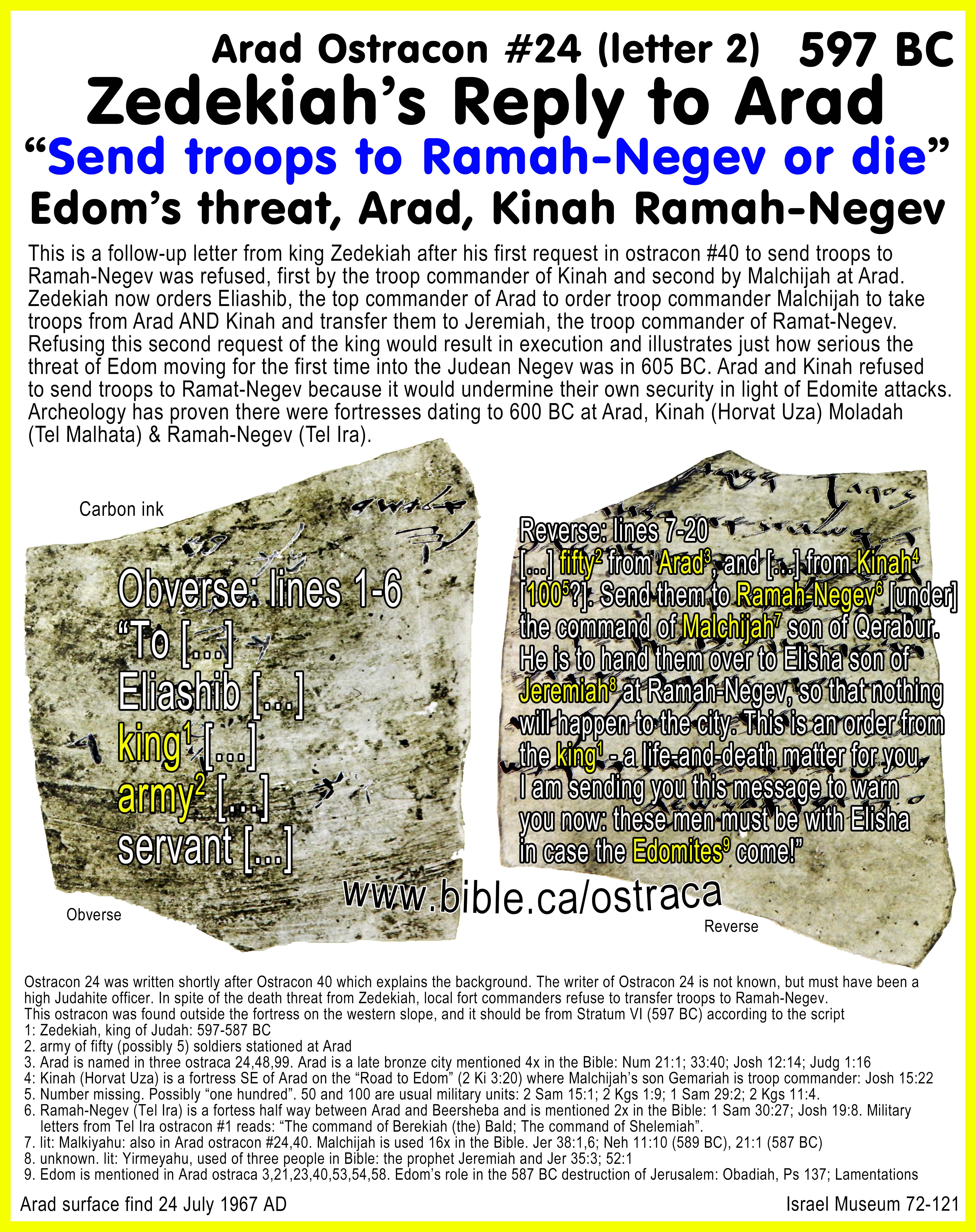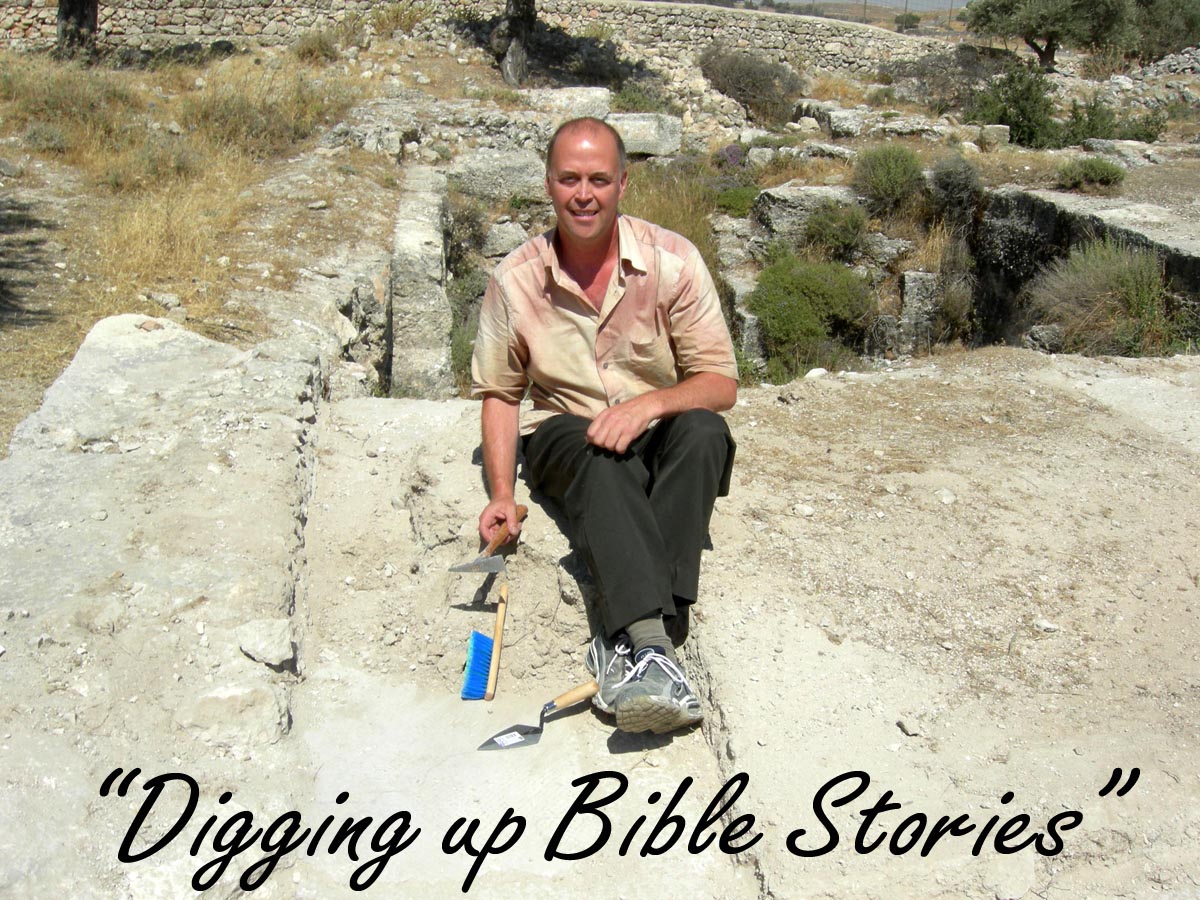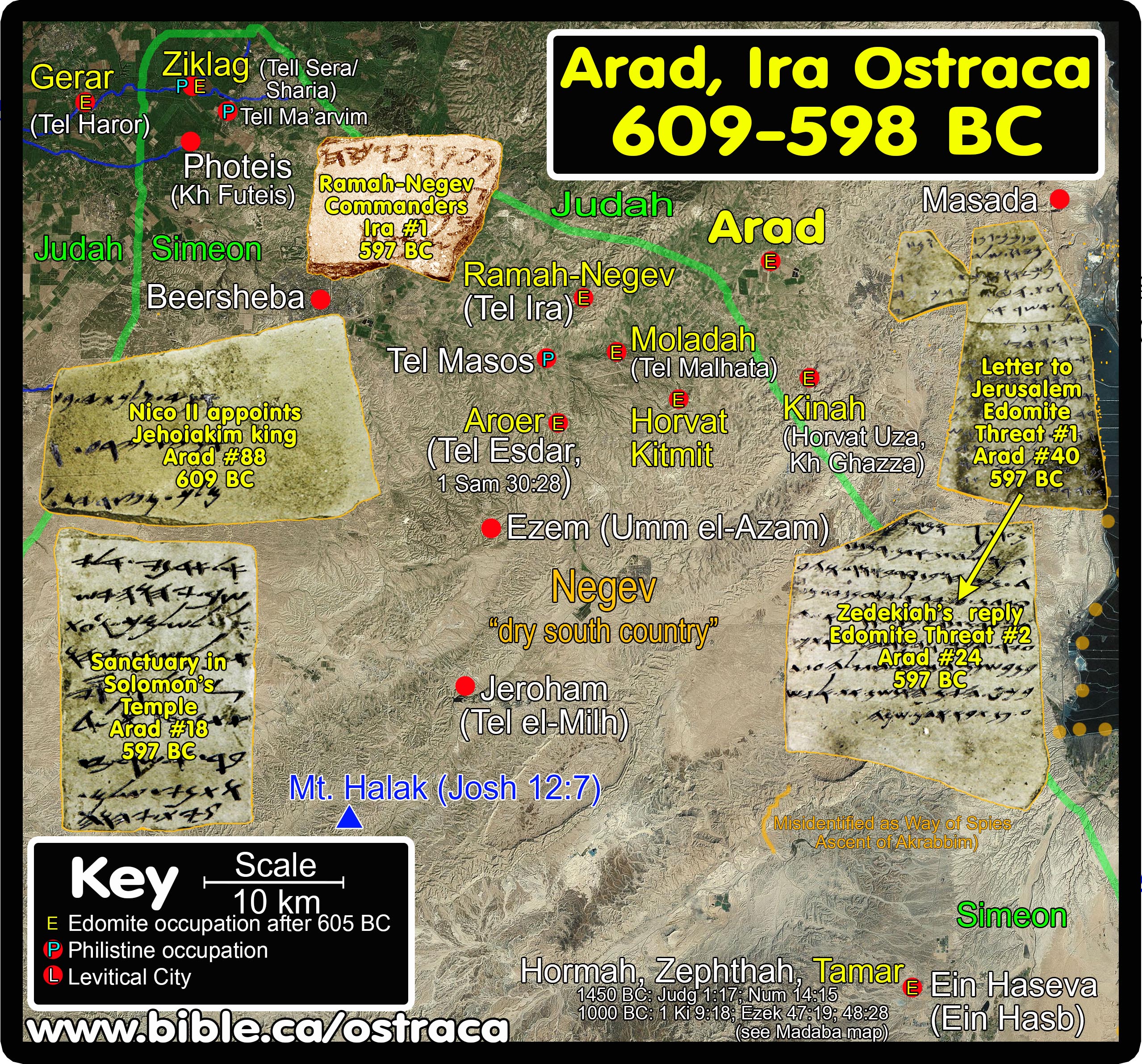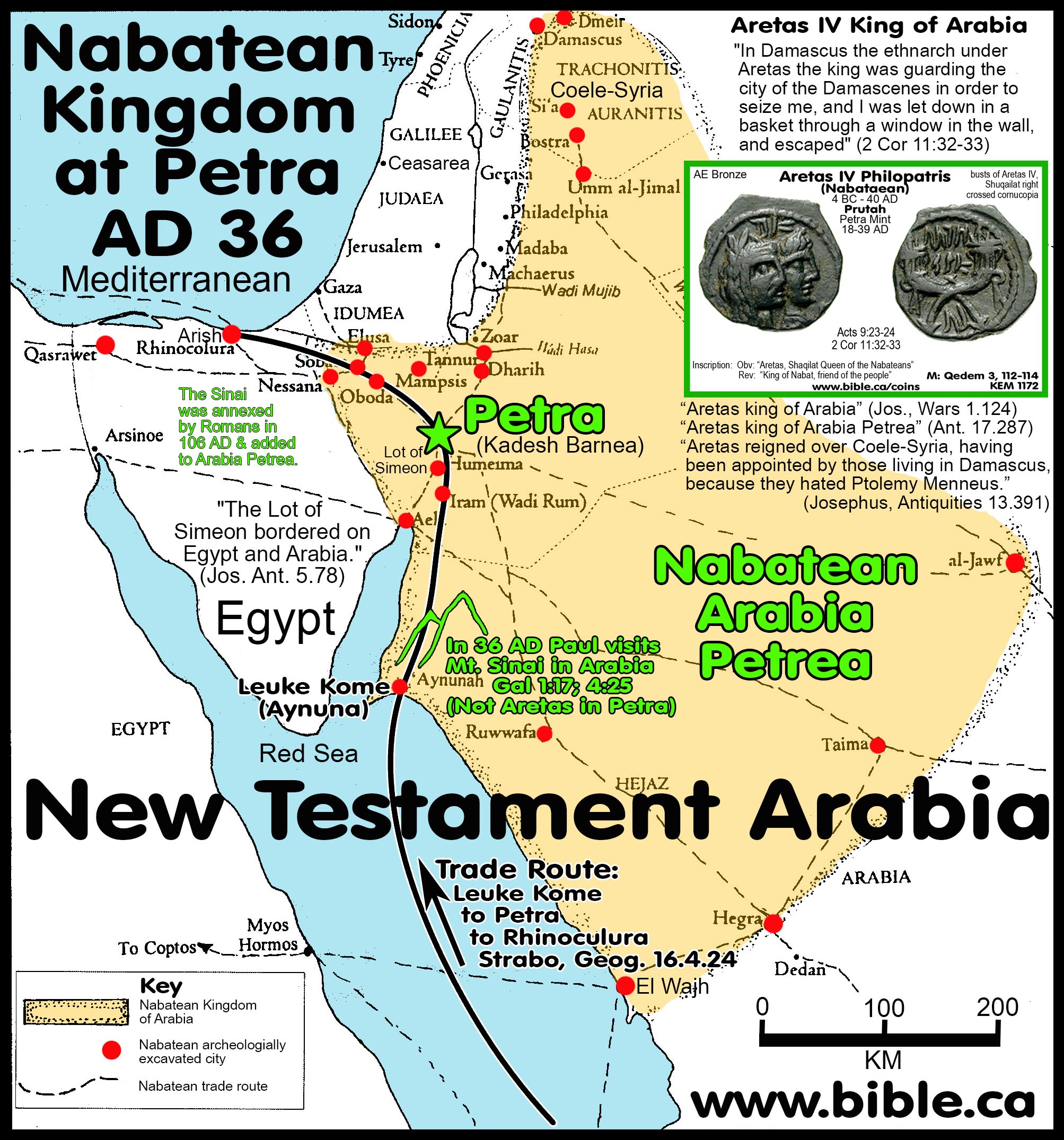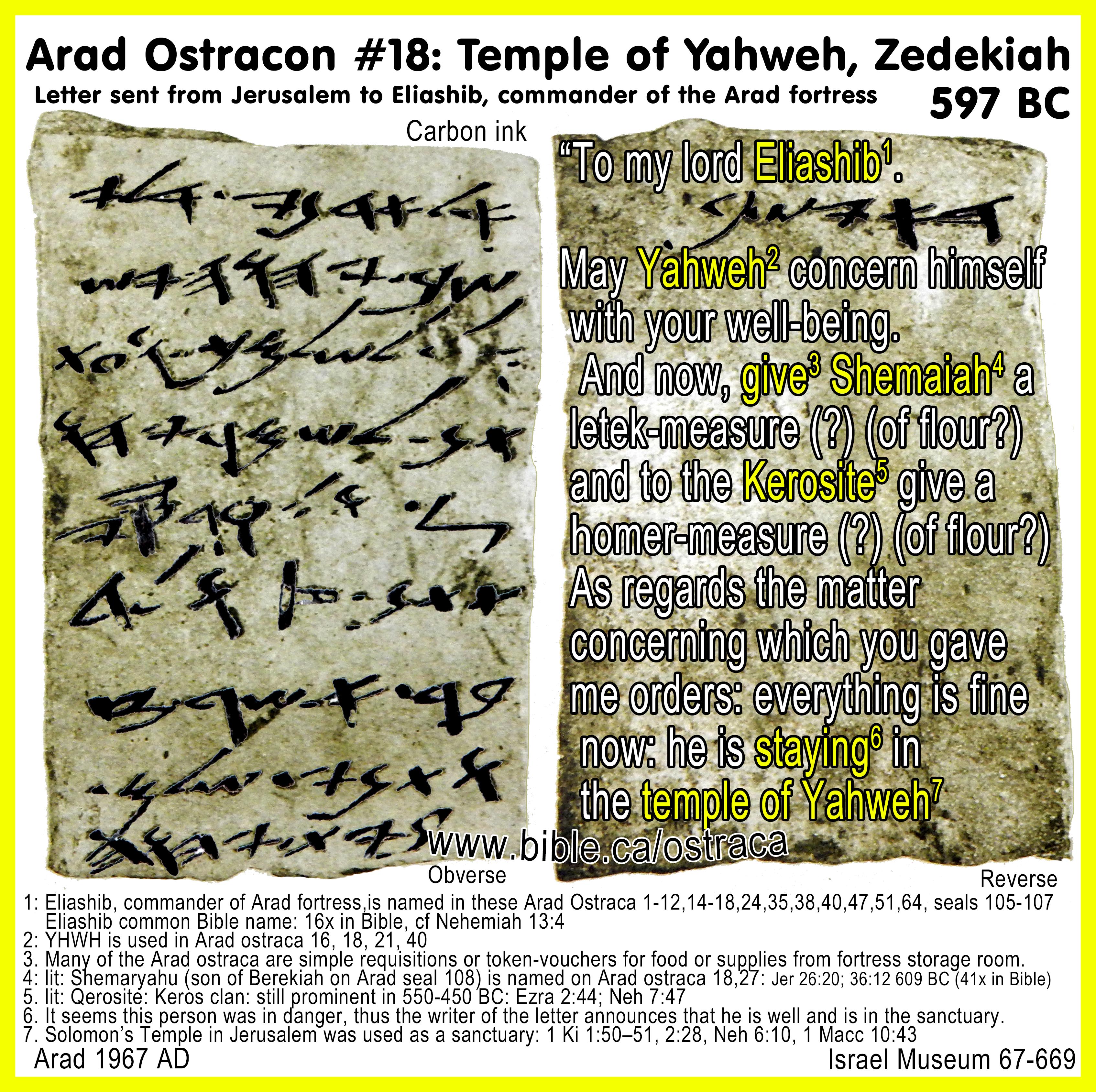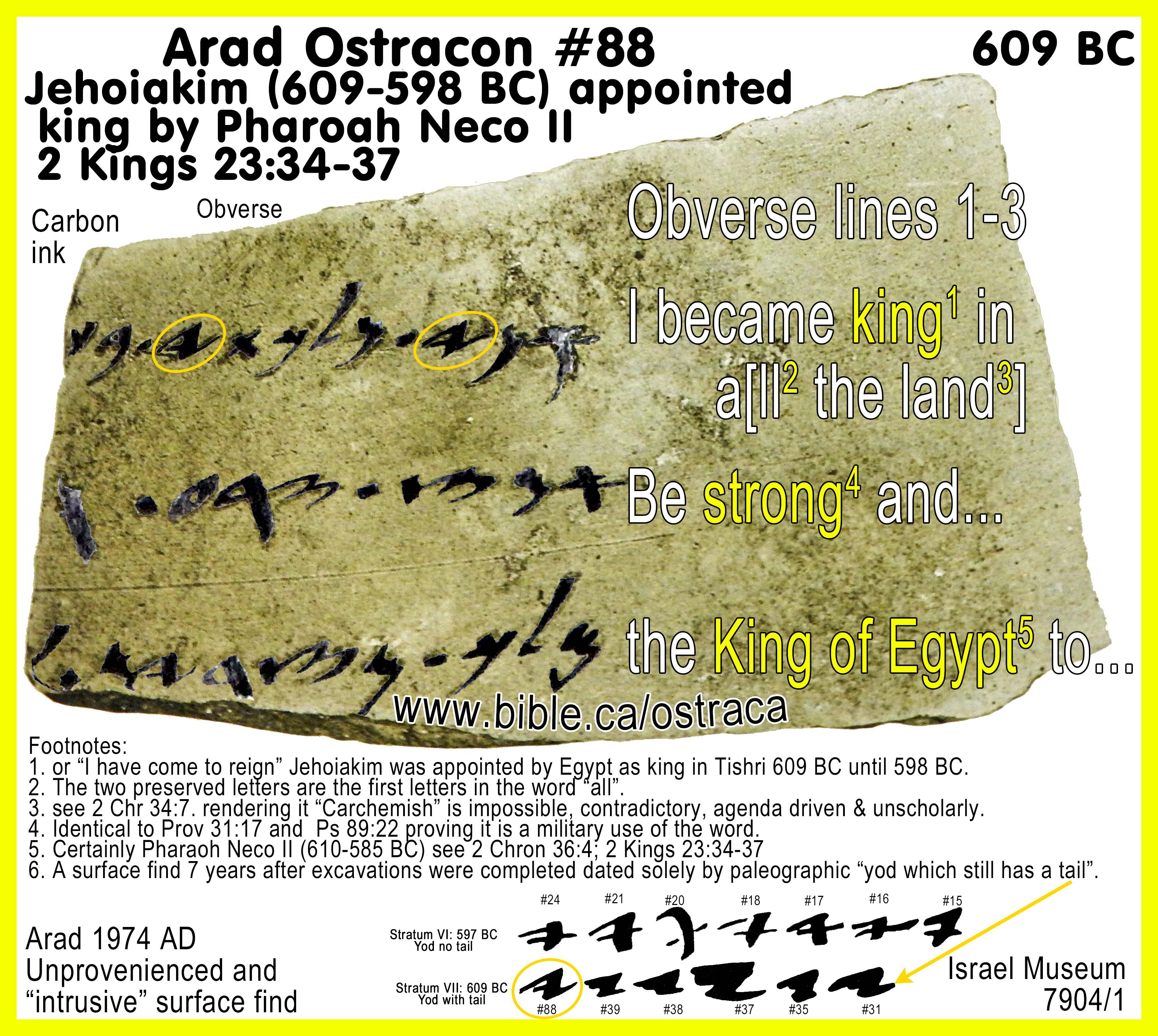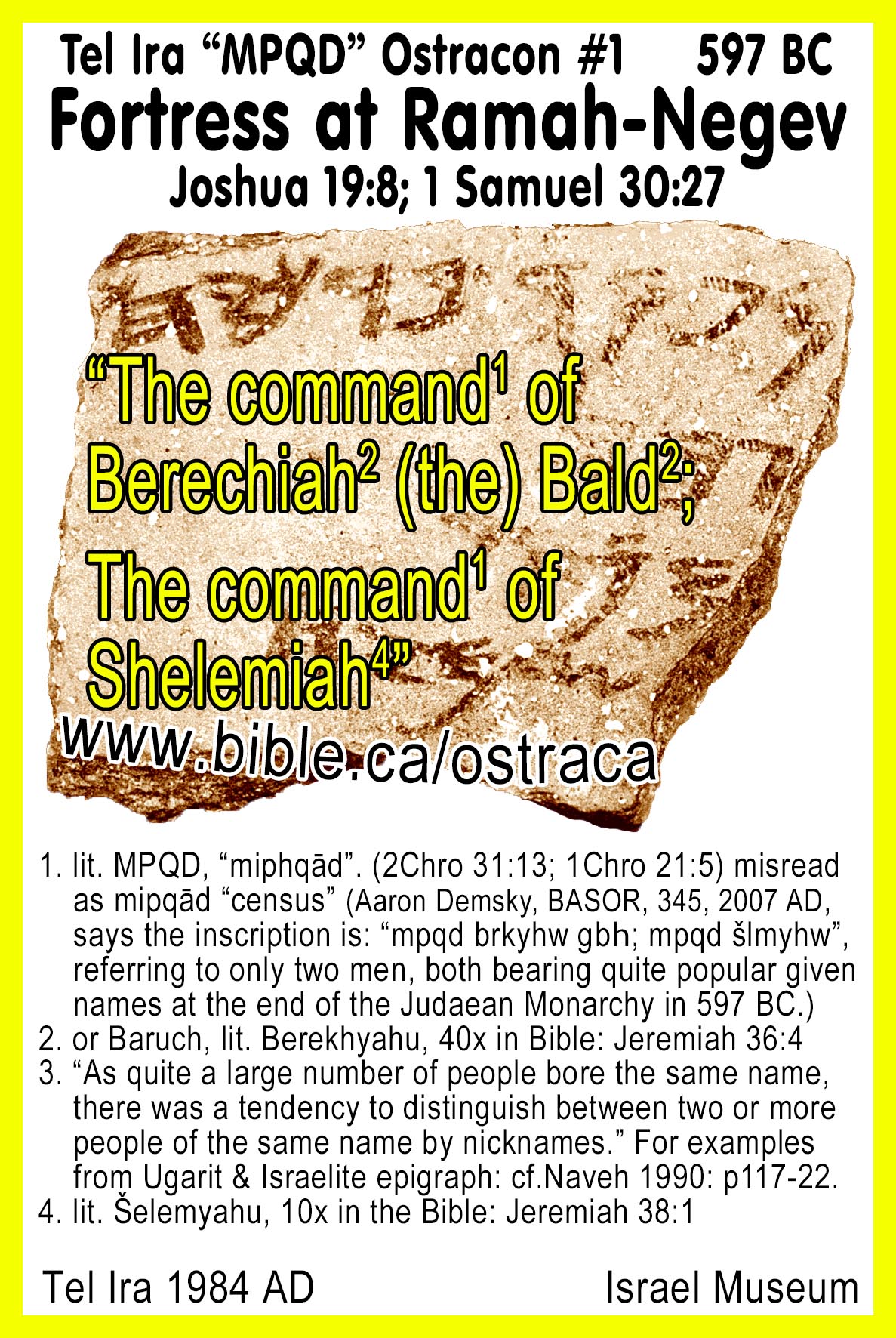Arad Ostraca #24 (597 BC) Zedekiah and the Edomite invasion into Judah
Letter 2 from Zedekiah to Arad: Send troops to Ramah-Negev or be executed!
Ostraca, Tablets and Inscriptions of the Bible
Letter
1: Arad
Ostracon #40 Letter to Zedekiah: "We won't send troops" 597 BC (this page)
Letter 2: Arad
Ostracon #24 Letter from Zedekiah: "Send troops or be executed" 597
BC
|
Video: Arad Ostraca, Zedekiah, and the Edomite attack in 597 BC Steven Rudd Near Eastern Archaeological Society (NEAS) lecture November 2020 |
The amazing story told in Arad ostraca 40 and 24:
|
Letter 1: |
Letter 2: Arad Ostracon #24 Letter from Zedekiah: "Send troops or be executed" |
The story told by Ostraca #40 and 24:
1. Edomite history: At age 30, Esau moves from Judah to Seir, conquers the Horites in 1926 BC and begins to occupy their historic Transjordan territory east of the Arabah valley in the highlands of modern Jordan. During the time of the Exodus 1446 BC, Edom's territory ran beside Kadesh Barnea at Nabatean Petra from the gulf of Aqaba north to the Wadi Zered at the south end of the Salt Sea. After continuously occupying their historic Transjordan lands for 1321 years, they began to move west into the Judean Negev, for the first time, after Nebuchadnezzar's first attack on Jerusalem in 605 BC. By 597 BC the Edomite Threat became very serious when one of the four Negev Judean fortresses, Ramah-Negev, was about to be captured by the Edomites. See also Edomite history
2. Letter 1: Zedekiah issues orders to Malchijah, the troop commander at the Arad fortress, to send 50 troops from Arad and 50 troops from the nearby Kinah fortress, to the fortress at Ramah-Negev to secure its safety and defense. We do not have this letter but know is exists based upon Ostracon #40
3. Letter 2: Malchijah, the commander of Arad fortress, relays Zedekiah’s instructions, by sending a messenger named Eshijah, to his son Gemariah, who is the commander of the Kinah fortress, with orders to send 50 troops to defend the Ramah-Negev fortress from the Edomites. Eshijah the messenger asks to read the letter he had brought, after but Gemariah refused to let him read the private correspondence between the two fortress commanders. We do not have this letter but know is exists based upon Ostracon #40
4. Letter 3: Arad Ostracon #40: Ostracon #40 is a reply to letter #2. Gemariah, the commander of the Kinah fortress, replies on Ostracon #40 to his father, Malchijah, the commander of the Arad fortress that he will not send reinforcement troops to Ramah-Negev in defense of the Edomite attack. Gemariah, therefore disobeyed both his father at Arad and King Zedekaih in Jerusalem. Ostaracon #40 reads, "No, we will not send any of our troops to Ramah-Negev as directed by the king." The reason was because moving the troops out of Kinah to nearby Ramah-Negev would seriously endanger the security of Kinah itself against the Edomites! There were simply not enough troops to secure both fortresses at Kinah AND Ramah-Negev. See: Arad Ostracon #40 Letter to Zedekiah: "We won't send troops" 597 BC
5. Letter 4: When Malchijah, the commander at Arad, got the message from his son, who was the commander at Kinah, he apparently agreed with the danger Kinah would face if Zedekiah's order to move troops was obeyed. Malchijah, the commander of Arad then wrote king Zedekiah informing him that neither Kinah or Arad would be sending troops to Ramah-Negev. We do not have this letter but know is exists based upon Ostracon #40 and Ostracon #24
6. Letter 5: Ostracon #24. Zedekiah’s reply: “send troops to the Ramah-Negev fortress or be executed”! When King Zedekiah read Malchijah's defiant reply it angered King Zedekiah recorded his threatening response in a second order to send troops on Ostracon #24. The letter was sent to Eliashib, who was the kings executive agent at the Arad fortress. Arad ostraca #24 says, “Send 50 soldiers from Arad and 100 from Kinah under the command of Malchijah from Arad, and deliver them to the command of Elisha, commander of the Ramah-Negev fortress that is under Edomite attack.” See: Arad Ostracon #24 Letter from Zedekiah: "Send troops or be executed" 597 BC
7. Result: In the end, we know from archeology, that all four fortresses were lost to the Edomites by the time Nebuchadnezzar makes his third and final attack on Jerusalem in 587 BC when Solomon's temple is destroyed. The Edomites even assisted in destroying the city and looted even the Temple itself. During the final 587 BC Babylonian attack on Judah many Jews fled for their lives and were captured and killed by the Edomites at the crossroads near the Arad, Kinah, Ramah Negev and Moladah fortresses. "To Edom: Do not stand at the fork of the road To cut down their fugitives; And do not imprison their survivors In the day of their distress." (Obadiah 10-14) Edom was condemned by God for its role in the destruction of Judah, Jerusalem and Solomon's temple in 587 BC and became an extinct nation by the time Judah returned from captivity in 536 BC. “To Edom: Like the overthrow of Sodom and Gomorrah with its neighbors,” says the Lord, “no one will live there, nor will a son of man reside in it." (Jeremiah 49:16-18)" (Steve Rudd, 2015 AD)
|
Digging up Bible stories! 5 ostraca document 3 important Bible events: 1. Pharaoh Nico II appoints Jehoiakim king of Judah in 609 BC. 2. Edomites move into the Judean Negev and Zedekiah orders troops for defense. 3. A man seeks asylum in the temple of Solomon. See also: Outline on Josiah King of Judah (640-609 BC) Outline on Jehoiakim king of Judah (609-598 BC) Outline on Zedekiah King of Judah (597-587 BC) Outline on Gedaliah 1st Governor of Judah (587 BC) "What we read in the book, we find in the ground" |
Click here for SPECIAL INTRODUCTION TO ALL ARAD OSTRACA
|
|
|
Arad Ostracon #24: Zedekiah's Reply: "Send troops or be executed!" |
|
|
Introduction to Arad ostracon #24:
- Read first to understand Arad ostracon #24 better: Archeological introduction to Arad Ostraca
- Quick summary of Arad ostracon #24
- "By 597 BC the Edomite Threat became very serious when one of the four Negev Judean fortresses, Ramah-Negev, was about to be captured by the Edomites. Zedekiah issues orders to Malchijah, the troop commander at the Arad fortress, to send troops from Arad and the nearby Kinah fortress, to the fortress at Ramah-Negev to secure its safety and defense. Malchijah relays the Zedekiah's orders to his son Gemariah who commands the fortress at nearby Kinah. Arad Ostracon #40 (Arad Ostracon #40 Letter to Zedekiah: "No troops sent" 597 BC) is a letter written on a broken pottery sherd from Gemariah to his father Malchijah at Arad that records the message that defies both his father Malchijah and King Zedekiah: "No, we will not send any of our troops to Ramah-Negev as directed by the king." The reason was because moving the troops out of Kinah to nearby Ramah-Negev would seriously endanger the security of Kinah itself against the Edomites! There were simply not enough troops to secure both Kinah AND Ramah-Negev. When Malchijah got this message from his son from Kinah, he apparently agreed with the danger Kinah would face if Zedekiah's order to move troops was obeyed. Malchijah wrote king Zedekiah informing him that neither Kinah or Arad would be sending troops to Ramah-Negev." (Steve Rudd, 2015 AD)
- "Arad Ostraca #24 (Arad Ostracon #24 Letter from Zedekiah: "Send troops or be executed" 597 BC) is a follow-up letter from king Zedekiah after his first request in Arad Ostracon #40 Letter to Zedekiah: "No troops sent" 597 BC, to send troops to Ramah-Negev was refused, first by the troop commander of Kinah and second by Malchijah at Arad. Zedekiah now orders Eliashib, the top commander of Arad to order troop commander Malchijah to take troops from Arad AND Kinah and transfer them to Jeremiah, the troop commander of Ramah-Negev. Refusing this second request of the king would result in execution and illustrates just how serious the Edomite Threat was with Edom moving for the first time, into the Judean Negev in 605 BC. Arad and Kinah refused to send troops to Ramah-Negev because it would undermine their own security in light of Edomite attacks. Archeology has proven there were fortresses dating to around 600 BC at Arad, Kinah (Horvat Uza) Moladah (Tel Malhata) and Ramah-Negev (Tel Ira)." (Steve Rudd, 2015 AD)
- 5 letters: A Snapshot of the storyline reconstructed from the two ostraca letters #40 and #24:
a. Letter 1: Zedekiah sends a letter from Jerusalem to the Arad commander to send 50 troops from Arad and 50 troops from the nearby Kinah fortress to reinforce the Ramah-Negev fortress which is under attack by the Edomites.
b. Letter 2: The Arad commander sends a letter to his son, the commander at Kinah.
c. Letter 3: Ostracon #40 is the Kinah commander’s reply to his father at Arad refusing to obey Zedekiah’s request.
d. Letter 4: The Arad commander sends a reply back to Zedekiah in Jerusalem that neither Arad or Kinah will send troops to defend Ramah-Negev against the Edomites.
e. Letter 5: Ostracon #24 Zedekiah replies to the two fortress commanders: “Send the troops or be executed”.
- Translation of Arad ostracon #24:
- […] fifty2 from Arad3, and […] from Kinah4 [1005?]. Send them to Ramah-Negev6 [under] the command of Malchijah7 son of Qerabur. He is to hand them over to Elisha son of Jeremiah8 at Ramah-Negev, so that nothing will happen to the city. This is an order from the king1 - a life-and-death matter for you. I am sending you this message to warn you now: these men must be with Elisha in case the Edomites9 come!”
- For red footnotes see below.
- Brackets […] indicate missing, damaged or unreadable text.
- The story in Arad ostraca 40 and 24: (refer to map for place locations)
- "5 men from Arad and 5 men from Kinah must assemble at Moladah, and Malkiyahu, an officer who was probably responsible for the military forces in the eastern Negev, will lead them from this place to Ramah-Negev and turn them over to Elisha son of Jeremiah, the fort's commander. The emergency is due to an impending Edomite attack on Ramah-Negev (line 20: "lest Edom comes there"). … The troops from Arad and Kinah must have assembled at Moladah (Tel Malhata), which is located in the juncture of the two places, on the main road leading to nearby Ramah-Negeb." (Ostracon 40 from Arad reconsidered, Nadav na'aman, 2003 AD)
- Zedekiah had previously ordered Malchijah, (troop commander Arad) that both he and his son Gemariah, (troop commander of Kinah), must to send troops to Ramah-Negev in defense of Edomite attacks. Malchijah had relayed this order by sending Eshiyahu to his son at nearby Kinah and ostracon #40 is the reply to this request: NO! (Steven Rudd, 2015 AD)
- Arad #40 "Letter to Zedekiah", is Gemariah and Nehemiah’s reply to Malchijah in Jerusalem where they refuse to send troops to Ramah-Negev because of the threat of Edomite attacks at their fortress of Kinah. Archeology has proven there were fortresses dating to around 600 BC at Arad, Kinah (Horvat Uza) and Ramah-Negev (Tel Ira). (Steven Rudd, 2015 AD)
- Arad ostraca #24 is Zedekiah's angry reply to Arad #40 "Letter to Zedekiah", after they refuse to send troops. (Steven Rudd, 2015 AD)
- In Arad ostraca #24 : Zedekiah commands them: "SEND THE TROOPS OR BE EXECUTED!"
- Read the first letter sent to Zedekiah's on Arad ostraca
40 where the soldiers refuse to send troops: Arad
#40 "Letter to Zedekiah"

- Arad ostraca letter #40 was written first and letter #24 is the reply!
- Ostracon 24 was written shortly after Ostracon 40 which explains the background. The writer of Ostracon 24 is not known, but must have been a high Judahite officer. In spite of the death threat from Zedekiah, local fort commanders refuse to transfer troops to Ramah-Negev.
- Ostracon 24 was found outside the fortress on the western slope, and it should be from Stratum VI (597 BC) according to the script
- "In my opinion, Ostracon 40 was written shortly before Ostracon 24 and explains the background of the latter. The writer of Ostracon 24 is not known, but must have been a high Judahite officer. In light of the refusal of local fort commanders to transfer troops to other places, a strict order —whose violation could incur the death penalty — is declared. … Ostraca 24 and 40 reflect the state of emergency in the Negeb of Judah in the last years of the kingdom of Judah. The Edomite danger looked so threatening that fort commanders dared refusing the instructions of their superiors to transfer soldiers located in their place to other locations, and the high command found it necessary to issue strict orders, threatening the disobeyer with death penalty, in order to get their commands fulfilled. The number of soldiers in each place must have been small and the problem of manpower severe, and local commanders, though being aware of the danger to their place, were unable to comprehend the overall picture. Under these circumstances, the high command found it necessary to impose its authority and enforce the local officers to obey its orders." (Ostracon 40 from Arad reconsidered, Nadav na'aman, 2003 AD)
- "The writer emphasizes his fidelity and his strict adherence to the orders he received. In a previous letter, he had already informed Malkiyahu of what a certain man wanted of him. He points out that he sent the letters (?) to Malkiyahu on the same day that he received them from Edom. These letters probably contained threats or unpleasant information. He tells him that Eshiyahu (the same person who came to him from Arad?) slept at his house and asked to see the letter, but was refused — probably according to instructions from Malkiyahu. Finally, he requested that the King of Judah be told that they cannot send the requested article because of some evil that Edom effected." (Arad Inscriptions, Yohanan Aharoni, Arad inscription 40, p 70, 1981 AD)
- "The background of the letter is a request by Eshyahu, possibly a royal messenger, to transfer the troops stationed with Gemaryahu and Nehemyahu, to another place. He had already met them (lines 6-7), and his request was discussed verbally between Malkiyahu and the writers (lines 4-6). Eshyahu also met Malkiyahu, and arrived, probably for a second time, at the writers' place. In the ostracon they restate their position in the debate. Firstly, they make it clear that they refused Eshyahu's request to transfer troops (lines 8-9). They add that Malkiyahu must be aware of the severity of the situation, as he has recently received updated news from Edom (lines 9-11). He must therefore support their refusal to transfer the troops from their place. Secondly, they report that Eshyahu is still in their place and ask for the letter from Edom. Finally, they make a bold statement, which Malkiyahu should relate to the king of Judah: There is a serious Edomite threat against their place, possibly Qinah (Herbal- `Oza), a fort located in the easternmost side of the Beer-sheba Valley (see below), and as long as it continues it would be impossible to move the troops to another location." (Ostracon 40 from Arad reconsidered, Nadav na'aman, 2003 AD)
- "Even though not all of the completions enjoy the same degree of certainty, the contents of the letter are clear on the whole. Gemaryahu and Nehemyahu assert that they are obedient to their superior, Malkiyahu, the commander of Arad at this time. It appears that Gemaryahu is the commander of one of the fortresses to the south of Arad, perhaps Ramah-Negeb mentioned in Inscription 24 as the first station on the border with Edom." (Arad Inscriptions, Yohanan Aharoni, Arad inscription 40, p 70, 1981 AD)
I. Mapping the surrounding cities: Arad, Kinah, Moladah and Ramah-Negev
- The story on the two Arad ostraca (40, 24) involved 4 city fortresses in 597 BC:
- Arad: a major fortress in command over two other fortresses: Ramah-Negev
- Kinah located 10 km south of Arad (Horvat Uza, Khirbet Ghazza)
- Moladah (Tel Malhata) located 10 km south west of Arad.
- Ramah-Negev, (ie. high place of the desert) 10 km west of Arad. (Tel Ira)
- Archeology has proven there were fortresses dating to around 600 BC at Arad, Kinah (Horvat Uza) and Ramah-Negev (Tel Ira) and Moladah (Tel Malhata)
|
"5 men from Arad and 5 men from Qinah [Kinah] must assemble at Moladah, and Malkiyahu, an officer who was probably responsible for the military forces in the eastern Negev, will lead them from this place to Ramah-Negev and turn them over to Elisha son of Jeremiah, the fort's commander. The emergency is due to an impending Edomite attack on Ramah-Negev (line 20: "lest Edom comes there"). Lemaire identified Qinah at Horvat Uza (Khirbet Ghazza) and Ramah-Negeb at Tel Ira, and his suggested identifications were accepted by other scholars. Tel Malhata is identified with Malatha, an Idumean fortress in the late Second Temple period and later a fort garrisoned. Although the names Moladah and Malatha/Moleatha are etymologically different, in light of the similarity of the topographical data and the sound of names, Abel suggested identifying Moladah at Tel Malhata. In my opinion, Abel's suggested identification for Tel Malhata is the best so far, and, if correct, corresponds with my restoration of Ostracon 24:12. The troops from Arad and Qinah must have assembled at Moladah (Tel Malhata), which is located in the juncture of the two places, on the main road leading to nearby Ramah-Negeb (Tel `Ira'). For the excavations of Tel Malhata, see Kochavi 1993, with earlier literature; Eldar and Baumgarten 1993; Beit-Arieh 1998." (Ostracon 40 from Arad reconsidered, Nadav na'aman, 2003 AD) |
II. Edom's role in the destruction of Solomon's temple in 587 BC:
- The Edomite Threat: 605 - 587 BC
- Arad ostraca inscription number 40 and Arad ostraca inscription number 24 are an amazing window into the world of Zedekiah in 597 BC and the encroachment of Edom into the Judean Negev for the first time in history.
- Arad ostraca 40 and 24 illustrate the serious Edomite threat in the Judean Negev to Zedekiah in 597 BC, when local fort commanders disobeyed, under threat of death, a strict order of King Zedekiah. Arad ostraca #40 was written first and #24 is the reply.
- The two ostraca [Arad inscription 40 and inscription 24] illustrate the state of emergency in the Negeb of Judah in the last years of the kingdom of Judah, when the high command found it difficult to impose its authority on the local fort commanders and was obliged to issue strict orders and even threaten them with the death penalty for its commands to be obeyed." (Ostracon 40 from Arad reconsidered, Nadav na'aman, 2003 AD)
- This is important because it proves Kadesh Barnea CANNOT be located at Ein Qudeirat in the Sinai, but rather at Petra.
- Kadesh Barnea is located ON THE BORDER with Edom and because Edom was never anywhere near Quderat (see map below) in 1406 BC this forces Kadesh into modern Jordan.
- Only after 605 BC did Edom, for the first time in history, move into the Judean Negev.
- See outline
on Edom and more information below.
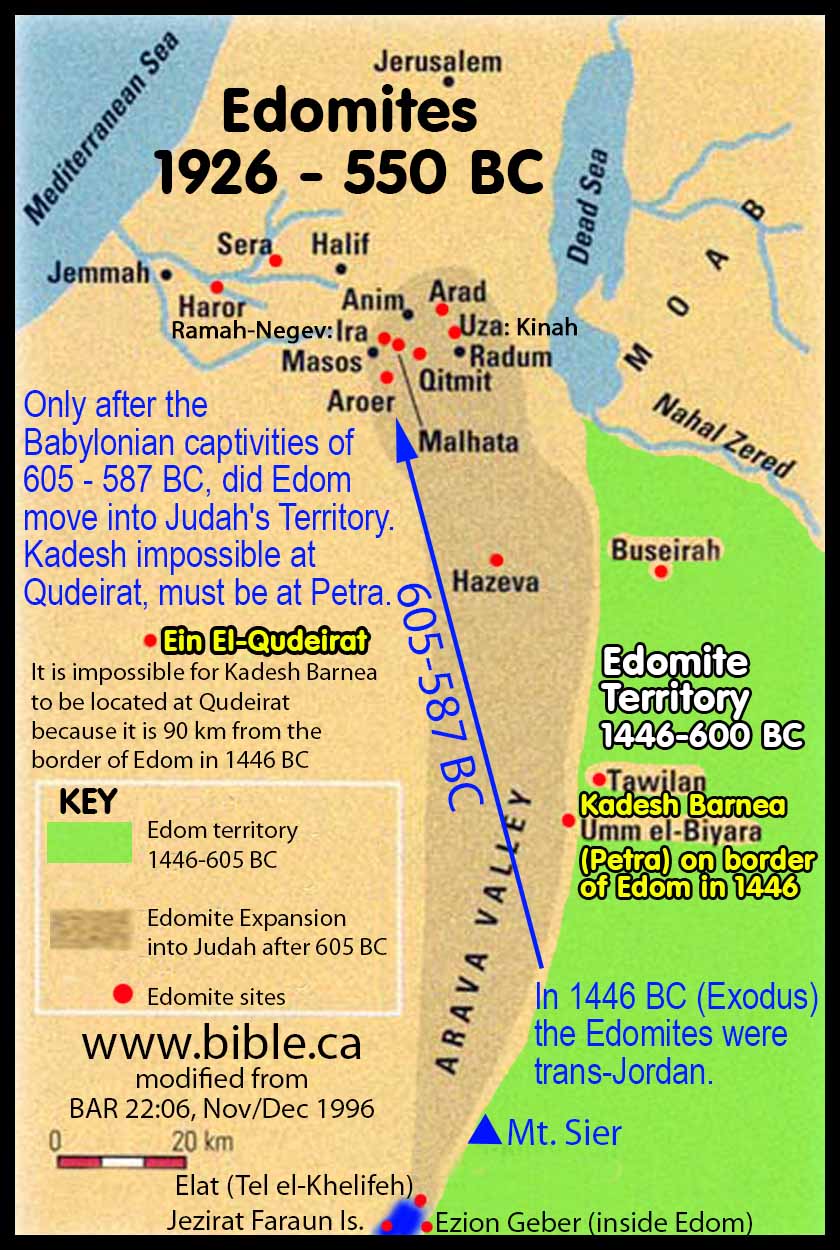
- The current location of Kadesh Barnea in every almost
Bible map today is wrong. Take note that before 1916 AD, most Bible
scholars located Kadesh Barnea either at Petra or nearby.
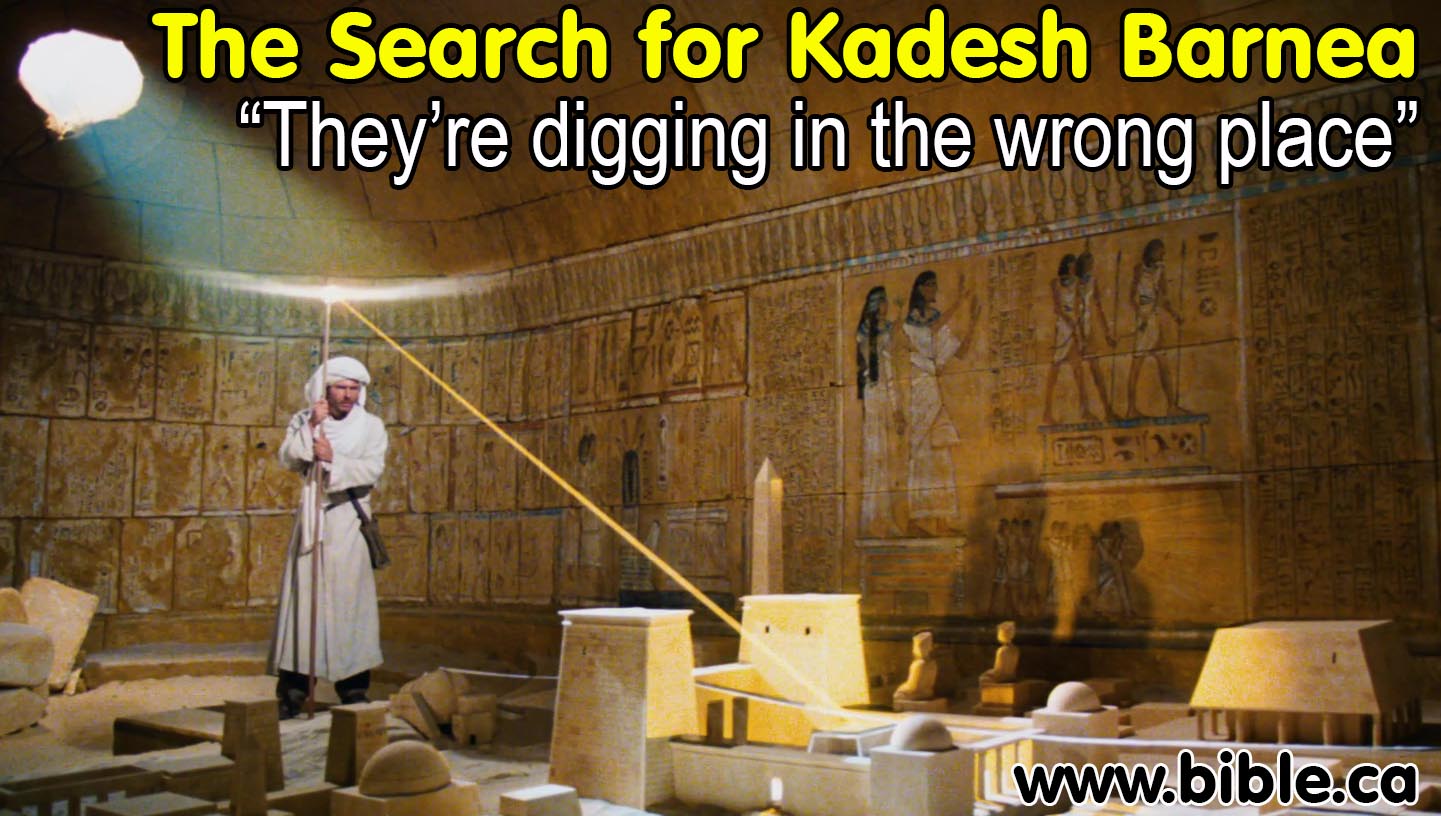
- Condemnation for Edom for its role in the 587 BC destruction of Judah and Temple: Obadiah 10-14, Ps. 137:7; Lam. 4:21; Ezek. 25:12-14; 32:29; 35:1-15. 1 Esdras 4:45. Jer 27:1-3; 49:13, 16-18.
- "the day of Jerusalem’s fall, how Edom said, “Tear it down! Tear it down! Down to its foundations!”" (Psalm 137:7)
- "Edom acted revengefully against the house of Judah" (Ezekiel 25:12–14)
- "Edom cherished an ancient enmity, and gave Israel to the power of the sword at the time of their calamity, at the time of their final punishment" (Ezekiel 35:5)
- "Edom said, ‘These two nations [Israel and Judah] and these two lands will be mine, and we will possess them'" (Ezekiel 35:10)
- "“As you rejoiced over Israel because it was desolate" (Ezekiel 35:15)
- "“Because of violence to your brother Jacob, on the day that you stood aloof, on the day that strangers carried off his wealth, And foreigners entered his gate And cast lots for Jerusalem- You too were as one of them. “Do not gloat over your brother’s day, “Do not enter the gate of My people In the day of their disaster. And do not loot their wealth In the day of their disaster. Do not stand at the fork of the road To cut down their fugitives; And do not imprison their survivors In the day of their distress." (Obadiah 10-14)
- "Cyrus vowed to rebuild the temple which the Edomites set on fire when Judah was devastated by the Chaldeans." (1 Esdras 4:45)
- Edom will become an extinct nation:
- "Bozrah will become an object of horror, a reproach, a ruin and a curse; and all its cities will become perpetual ruins.” (Jeremiah 49:13)
- "The arrogance of your (Edom's) heart has deceived you, Though you make your nest as high as an eagle’s, I will bring you down from there,” declares the Lord. “Edom will become an object of horror; everyone who passes by it will be horrified and will hiss at all its wounds. “Like the overthrow of Sodom and Gomorrah with its neighbors,” says the Lord, “no one will live there, nor will a son of man reside in it." (Jeremiah 49:16–18)
- The Nabateans who rebuilt tomb city of Kadesh Barnea occupied by Moses during the exodus (1444-1407 BC) into the Petra we see today are a mystery.
- The Nabateans come onto the world stage for the first time about 350 BC.
- Edom went extinct about 550 BC when they were destroyed by Babylon.
- Some speculate that the Nabateans are the remnant of Edom.
- The origin of the Nabateans remains a mystery but it is certainly not Edom.
- God said that Edom would become an extinct nation and we can see the huge boundaries of the Nabatean kingdom in 50 BC at its greatest extent.
III. Translation of Arad
ostracon #24:
Ostracon 40 was written shortly before Ostracon 24 and explains the
background of the latter of #24
|
Obverse: “To […] Eliashib […] king1 […] army2 […] servant [...] Reverse: […] fifty2 from Arad3, and […] from Kinah4 [1005?]. Send them to Ramah-Negev6 [under] the command of Malchijah7 son of Qerabur. He is to hand them over to Elisha son of Jeremiah8 at Ramah-Negev, so that nothing will happen to the city. This is an order from the king1 - a life-and-death matter for you. I am sending you this message to warn you now: these men must be with Elisha in case the Edomites9 come!” (Steve Rudd adapted from Aharoni) For red footnotes see below. Brackets […] indicate missing, damaged or unreadable text. |
|
|
Steve Rudd's footnotes from his adapted translation above
|
|
A. Translation notes from: Arad Inscriptions, Yohanan Aharoni, Arad inscription 24, p 46, 1981 AD
Aharoni translation: "Obverse: To Eliashib... ... king … troop … mon[ey] … passed. Reverse: From Arad 50 and from Kin[ah]... And you shall send them to Ramah-Negeb by the hand of Malkiyahu the son of Qerab'ur and he shall hand them over to Elisha` the son of Yirmiyahu in Ramah-Negeb, lest anything should happen to the city. And the word of the king is incumbent upon you for your very life! Behold, I have sent to warn you today: [Get] the men to Elisha: Lest Edom should come there." (Arad Inscriptions, Yohanan Aharoni, Arad inscription 24, p 46, 1981 AD)
- The excavation reports for Arad Ostracon #24 are:
- Arad was excavated 1962-1967 AD.
- "Ostracon 40 from Arad was published by Y. Aharoni (1970: 28-32), and republished, with a much fuller set of restorations, in Nelson Glueck's Memorial Volume (Aharoni 1975), and in the edition of the Arad inscriptions (Aharoni 1981: 70-74). The text has been discussed in detail by some scholars, all of whom adopted Aharoni's restorations, with a few minor variations." (Ostracon 40 from Arad reconsidered, Nadav na'aman, 2003 AD)
- Arad Inscriptions, Yohanan Aharoni, Arad inscription 40, p 70, 1981 AD (The Hebrew version was published years earlier, but the english edition has many updates and corrections)
- Three Hebrew Ostraca from Arad, Y. Aharoni, BASOR 197, p 28, 1970 AD
- "The fifth and last season at the citadel mound in the summer of 1967, was directed jointly by the late Prof. Bernard Boyd and myself. During this season, 20 Hebrew and four Aramaic ostraca were found. The two most important Hebrew ostraca were: 1. (#76) an ostracon from Stratum XI (No. 76), the earliest Hebrew ostracon discovered to date, only partially preserved; 2. (#24) and an ostracon apparently from the archive of Eliashib, though it was not found in clear context (No. 24), in which the commanders of Arad and nearby citadels are called upon to prepare to repulse an Edomite attack." (Arad inscriptions, Joseph Yohanan Naveh, p5, 1981 AD)
- "This ostracon was found outside the fortress on the western slope, and it should be from Stratum VI according to the script. On the obverse, the beginning of the letter, there were at least 10 lines of writing, but aside from single letters it is illegible. Luckily, it is possible to read the first word with certainty: "Eliashib".2 Only the bet is doubtful since its lower part is missing. Thus it is possible to read instead, giving the name Elisha`; however, since the area beneath the letter is completely effaced, it is possible also to read it as bet. The script in this ostracon is identical to that of several of the Eliashib collection, thus making it likely that this, too, is part of Eliashib's archive. The opening was apparently written on the corner of the sherd above the word "Eliashib”. In this place there are remains which could fit these two letters, and since this was a long letter, it would appear that the scribe utilized every spare space on the sherd. Unfortunately, the rest of the script on this side is undecipherable3 aside from a few letters and words. It appears that in line 3 the word I'm "king" is written; in line 4 "troop"; and in line 6 perhaps the word "passed". The letters OD in line 5 may be completed "money", although all of this is doubtful." (Arad Inscriptions, Yohanan Aharoni, Arad inscription 24, p 46, 1981 AD)
- "The reverse of the ostracon, in contrast, is completely. legible aside from the first two lines which are broken slightly above and to the left. If we restore the broken parts above and below (the top part of the obverse), we have before us a square tablet, similar to some of the Eliashib sherds (especially Inscriptions 1, 2, 5, 7, 16, and 18). This fact, as well as the similarity of the script, supports the supposition that this letter and some of the Eliashib letters were sent from the same place." (Arad Inscriptions, Yohanan Aharoni, Arad inscription 24, p 46, 1981 AD)
B. Line by line: Arad Inscriptions, Yohanan Aharoni, Arad inscription 24, p 46, 1981 AD
- Line 12. From Arad - As in ostracon No. 4 from Lachish, this is the second time that the name of the place where the ostracon was found is mentioned in a Hebrew ostracon (and vid. also Inscription 99 and perhaps Inscription 48). Here, too, it is not at the beginning of the letter, but in the middle of a sentence. From the context, it is clear that people= soldiers are to be sent; thus a possible completion is: "And you will take 50 people from Arad After this word comes a number, but unfortunately its upper part is missing. We may suppose that this is an Egyptian hieratic numeral as in the other inscriptions from Arad and elsewhere in Judah and Israel. Since a horizontal line connects to the vertical line, 5 is the lowest possible number. However, since both of the lines are too long, it seems more likely that the number 50 is meant.' Good examples appear in Ostracori 19 (lines 3, 4) from Lachish' and in shekel weights from Jerusalem.' — only the first four letters of this word are clear. The fifth letter is broken, and its remains fit either kaf, mem. or nun. Bet or pe might also be possible, but these are usually straighter. Since a place name is necessary here, according to the context, the proposed completion seems certain. In the list of Judean towns, the name Kinah is mentioned as being near Arad (thus, instead of the mistaken Try; Josh 15:22). True, the remaining line is very similar to that of the mem in this letter, and nun is usually written shorter and more cursively; however, a nun with a similarly long downward line appears also in line 7 (the second letter). And it should he emphasized that the downward stroke reaches only the white dot, and does not continue to the left, as might be mistakenly seen in the photograph. At the end of the line, there is room for 6-8 more letters. It is possible to assume that after "Kinah" came a number, as after Arad, and afterwards there is room for one or two more words. The letter he opening the next line shows that the missing words were not another place name and number. A possibility is to complete the line "And from Kinah, one hundred", assuming that the upper edge of the sherd was narrower than the rest, and that the number was written out. In Inscription 7, there is an example of both a numeral and a word used for writing one date. It should be noted that fifty and a hundred are usual military units (2 Sam 15:1; 2 Kgs 1:9; 1 Sam 29:2; 2 Kgs 11:4).
- Line 13. Ramah-Negeb — The completion is certain, in the light of line 5. The city is mentioned in the Bible in the form (1 Sam 30:27) and 313 rim" (Josh 19:8). This ostracon does 'not help in deciding which of the two forms is correct, thus we chose arbitrarily the form, this completion, too, seems certain. "to send by the hand of" is a normal biblical phrase. For the sending of soldiers by the hand of someone, "And David sent forth the people, a third part under the hand of Joab, etc." (2 Sam 18:2).
- Line 14. Malkiyahu — a common biblical name (Malchiahr Known in the period under discussion are Pashhur the son of Malchiah, a minister of Zedekiah (Jer 21:1; 38:1), and Malchiah the king's son, also from the time of Zedekiah (Jer 38:6). Qerab`ur — All of the letters are clear, including the final resh. The double line at the end of the word is a combination of the remains of the resh and the word divider (the dot tinder this sign is not ink. but a brown stain). The name Qerab'ur is unknown from any other sources. It should he connected. apparently, with the (theophorous) element, as in the names — even though the last letter in the line is a little blurred. it is clearly a bet. There is no doubt that the word arm" was meant, and a similar exchange occurs in the word in line 18, and vid. the discussion there. The appearance of the yod in the hiph'il form of this word and in the word in line 17, shows that already in this period in Judah, the yod was used as a mater lectionis in the middle of a word, and not only in diphthongs."
- Line 15. - gave them into his care, and cf. "and had committed unto him men" (Jer 40:7). Elisha` — from the Bible, this name is only known as the name of the prophet Elisha son of Shaphat, but the name is also known from the Samaria ostraca and from seals. Yirmiyahu (Jeremiah) — a common name in the Bible." In this period, aside from the prophet, one of the charioteers (Jer 35:3) and the father of one of Josiah's wives (Jer 52:1) were named Jeremiah.
- Line 16. "Lest peradventure harm befall him" (Gen 52:4); "Beware that there be not a base thought in thy heart" (Deut 15:9).
- Line 17. "The word of the king" — the king's command, cf. Esther 1:12; Samuel 21:3.
- Line 18. The form "7/33" is known also from Phoenician and Aramaic inscriptions from northern Syria, such as at Zincirli and Sfire. However, the fact that in this epistle the letters pe and bet were exchanged twice shows that we have before us a more general phonetic phenomenon.15 The only possible conclusion is that at this time in Judah, the weak bet and pe were pronounced so similarly that they could be interchanged by the scribes. This is proof of spirantized consonants during this period,' and one more indication of the development of a special Judean dialect.
- Lines 18-19. — meaning "to adjure and to warn you"," a biblical expression, e.g.: "I testify against you this day" (Deut 32:46); "I forewarn you this day" (Deut 8:19; and vid. Gen 43:3; Exod 19:21; 1 Sam 8:9; 1 Kgs 2:42; Jer 11:7; Neh 13:21 etc.). — Being "na" someone is a biblical expression for friends or soldiers under orders of a man or officer, e.g.: 1 Samuel 22:6; 2 Samuel 1:11; 17:12; Jeremiah 26:42; 41:2,7. However, from the context of the letter, it is clear that this is no statement of fact, that the people have not yet come to Elisha. Nor is it a question, since only in this letter was the command given to bring the men to Elisha.'9 Thus clearly this is an abbreviated and aggressive form of speech, dictated apparently by the commander to the scribe: "The men (must as soon as possible) be with Elisha!" [In fact, we may have here a rare usage of 'et meaning "to", cf. in Taanach letter No. 1:18 and the standard usage of Ugaritic; Albright, BASOR 94 (1944), p. 17 n. 27. AFR] The men are sent as reinforcements for Ramah-Negeb, thus it is clear that soldiers are meant.
- Line 20. Edom — a collective name, instead of "the Edomites", cf. 131K or "And the Aramaeans fled" (2 Sam 10:18) etc. As to an analysis of the historical events mentioned in this letter, and the question of identifying the place names in it, vid. the summary below.
C. Footnotes: Arad Inscriptions, Yohanan Aharoni, Arad inscription 24, p 46, 1981 AD
- Footnote 1 This ostracon was found on the second day of the fifth season of excavations in a baulk left standing between two sections excavated in the previous season. One of the students, Ann Black of South Carolina, noticed it while digging, thus it was saved from dipping. Again we have before us a telling example of the chance preservation of the script.
- Footnote 2 In the beginning I was convinced that the first two letters "INC spelled "to", the normal opening in the majority of the letters, and afterwards came a name which could not be Eliashib. E. Puech, who worked on this section, suggested to me that the first word was the name without the opening "to", a suggestion with which I tend to agree. However, we have left the word in the text as a possibility.
- Footnote 3. I could not accept the other suggestions of Mr. Puech for this side of the ostracon, and he will publish them in a separate article.
- Footnote 4. Lemaire's suggestion (Ostraca, p. 354 IH, p. 189) to complete: In17e7 5 7q377:1 5 71377: [1=7;11] "Hear from Arad 5 and from Kinah 5 for war" is unacceptable. Under discussion here is not the enlistment of men, but rather sending soldiers or mercenaries from one place to another.
- Footnote 5. Cf. Moller, Hier. Pal. II, p. 56, No. 627. Lachish III, Pl. 48 A:2; Y. Aharoni, jubelschrift to Shemuel Yeivin, Jerusalem 1970, figs. 2, 3, 4 (Heb.); Y. Aharoni, BASOR 184 (1966), figs. 3a, 4f.
- Footnote 6. Y. Aharoni, BASOR 201 (1971), pp. 35f. Lemaire (Ostrava, pp. 353f. IH, p. 189), who reads "5", does not take into account that the upper part of the numeral is broken. The proposal also seems unlikely from a contextual point of view; five soldiers are not reinforcement enough to account for the gravity of the letter.
- Footnote 7. Vid. R. de Vaux, Ancient Israel, London 1961, p. 121f., 226.
- Footnote 8. Enc. bibl. IV, cols. 1128-29 (Heb.).
- Footnote 9. Vid. Encl. bibl. I, cols. 170-79; Lemaire, Ostraca, p. 255. And vid. also the name Uriyahu in Inscription 31:2.
- Footnote 10. In contrast to the assumption of Cross and Freedman, Orthography, pp. 51, 54ff. They too, however, point out the appearance of 1'17 "city", and perhaps trit "man", in the Lachish letters, and especially the appearance of Irt "Ziph" as well as nT on the royal seals with four wings. This is the early type of royal seals which, in my opinion, come from the end of the eighth century B.C.E., vid. Oz LeDavid, Jerusalem 1964, pp. 421f. (Heb.).
- Footnote 11. Vid. Enc. bibl. I, cols. 355-58 (Heb.).
- Footnote 12. Vid. Enc. bibl. III, (Heb. cols. 867f.); Y. Aharoni, IEJ 18 (1968), p. 167.
- Footnote 13. Vid. Donner-Rollig, Inschriften, Nos. 24:13; 214:17, 21-22; 215:18; 217:7; 222A:37; 222B:39-40, 42; 223B:5; 224:5-7; Jean-Hoftijzer, Dictionnaire, pp. 183f.
- Footnote 14. On the phonetic phenomenon of the pe-bet exchange (in connection with the `Apiru-Hebrew problem) vid. M. Weippert, The Landnahme der israelitischen Stiimme etc., Gottingen 1967. pp. 77ff.
- Footnote 15. Vid. Lemaire, Ostraca, p. 356. E. Y. Kutscher (JSS 10 [1965], pp. 21-51) fixes the time of their entry into the language in the period after the borrowing of the alphabet by the Greeks, circa the tenth and ninth centuries B.C.E.
- Footnote 16. M. Heltzer, Some Northwest Semitic Epigraphic Gleanings from the IX-VI Centuries B.C., Annali dell'Istituto Orientate di Napoli 31 (1971), p. 195.
- Footnote 17. On this meaning of the verb "1'371'7-, vid. Gesenius-Buhl, Handworterbuch, p. 568.
- Footnote 18. It is also impossible to accept Lemaire's proposal (Ostrava, pp. 358f. IH, p. 190) that Elisha's men were sent to warn Eliashib. We heard clearly that the men are to be sent to Elisha in order to be with him, and it appears that Malkivahu son of Qerab'ur is the bearer of the letter. There is also no linguistic evidence to support the phrase "31'7D T1X 047,3X- meaning "someone's men". All of the biblical examples speak of someone and the men with him (UV).
- Footnote 19. Now treated extensively' by Sh. Izre'el, Shanaton 3 (1978), 204-212.
The amazing story told in Arad ostraca 40 and 24:
|
Letter 1: Arad Ostracon #40 Letter to Zedekiah: "We won't send troops" (this page) |
Letter 2: Arad Ostracon #24 Letter from Zedekiah: "Send troops or be executed" |
Conclusion:
- Please also read the special introduction to all four Arad ostraca.
- Snapshot of the story on Ostraca #24:
- "By 597 BC the Edomite Threat became very serious when one of the four Negev Judean fortresses, Ramah-Negev, was about to be captured by the Edomites. Zedekiah issues orders to Malchijah, the troop commander at the Arad fortress, to send troops from Arad and the nearby Kinah fortress, to the fortress at Ramah-Negev to secure its safety and defense. Malchijah relays the Zedekiah's orders to his son Gemariah who commands the fortress at nearby Kinah. Arad Ostracon #40 (Arad Ostracon #40 Letter to Zedekiah: "No troops sent" 597 BC) is a letter written on a broken pottery sherd from Gemariah to his father Malchijah at Arad that records the message that defies both his father Malchijah and King Zedekiah: "No, we will not send any of our troops to Ramah-Negev as directed by the king." The reason was because moving the troops out of Kinah to nearby Ramah-Negev would seriously endanger the security of Kinah itself against the Edomites! There were simply not enough troops to secure both Kinah AND Ramah-Negev. When Malchijah got this message from his son from Kinah, he apparently agreed with the danger Kinah would face if Zedekiah's order to move troops was obeyed. Malchijah wrote king Zedekiah informing him that neither Kinah or Arad would be sending troops to Ramah-Negev." (Steve Rudd, 2015 AD)
- Letter 1: Arad Ostracon #40 Letter to Zedekiah: "No troops sent" 597 BC
- Letter 2: Arad Ostracon #24 Letter from Zedekiah: "Send troops or be executed" 597 BC (This page)
- Background to the story told by Arad ostraca #40 and #24:
- The date was 597 BC
- Zedekiah was king of Judah in Jerusalem. Outline on Zedekiah
- Nebuchadnezzar had already attacked Jerusalem in 605 making Jehoiakim a vassal king of Babylon. (Jehoiakim has been appointed king by Neco II in 609 BC, but this changed in 605 BC) Outline on Jehoiakim
- The Edomites, who have never in their history ever occupied a territory west of modern Jordan, begin to invade the southern Negev of Judah in 605 BC. They would eventually win, even playing a central role in the destruction of Jerusalem and the temple of Solomon in 587 BC.
- The story on the two Arad ostraca (40, 24) involved 4 city fortresses in 597 BC:
- Arad: a major fortress in command over two other fortresses: Ramah-Negev
- Kinah located 10 km south of Arad (Horvat Uza, Khirbet Ghazza)
- Moladah (Tel Malhata) located 10 km south west of Arad.
- Ramah-Negev, (ie. high place of the desert) 10 km west of Arad. (Tel Ira)
- Archeology has proven there were fortresses dating to around 600 BC at Arad, Kinah (Horvat Uza) and Ramah-Negev (Tel Ira).
- The new date assigned to Arad ostracon inscription number 40 brings an exciting new insight into the Edomite invasion that began with Nebuchadnezzar's first of three attacks on Jerusalem (605, 597, 587 BC)
- Archeology is a science that brings real historical objects out of the ground and assigns them a date and a story.
- Recent studies have shown that Arad ostracon #40 is one of a two letter series where #24 is the reply to #40.
- Both Arad ostraca 40 and 24 document in carbon ink on broken pottery sherds, the encroachment, for the first time, into the Judean Negev starting in 605 BC.
- See also:
a. Outline on Josiah King of Judah (640-609 BC)
b. Outline on Jehoiakim king of Judah (609-598 BC)
c. Outline on Zedekiah King of Judah (597-587 BC)
d. Outline on Gedaliah 1st Governor of Judah (587 BC)
- Finally it is worth noting that Arad ostracon has the personal name of the Hebrew God "YHWH" written on it from Exodus 3.
a. #18 also has YHWH on the sherd: Arad #18 "Solomon Temple Sanctuary"
- What you read in the Bible, you find in the ground!
|
Arad and Ramah-Negev Ostraca collection 609, 597 BC |
||
|
Arad Letters |
Excavated 1962-1967 AD from an official archeological dig, these ostraca were the written records of communications between Jerusalem and the city of Arad and the king in Jerusalem at the time Nebuchadnezzar attacked Jerusalem 605-587 BC. |
|
|
|
||
|
. Click here for SPECIAL INTRODUCTION TO ALL ARAD OSTRACA . |
||
|
|
||
|
Edomite attack on Judah |
Edomite attack on Judah |
|
|
|
||
|
Asylum inside the Temple of YHWH |
Jehoiakim becomes king in 609 BC |
|
|
|
||
|
Edomite attack on Judah |
Click to enlarge map |
|
|
|
||
By Steve Rudd: Contact the author for comments, input or corrections.
